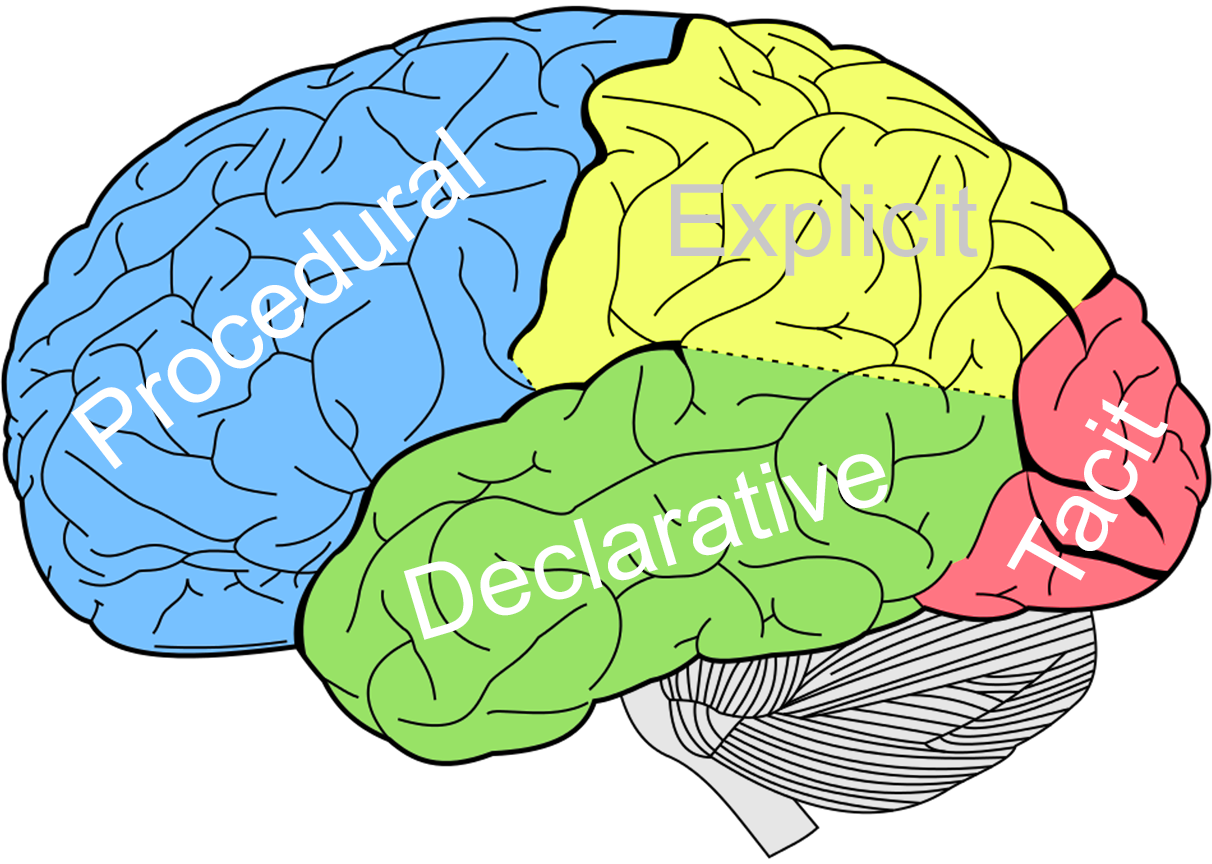Estimated reading time: 6 minutes

Declarative knowledge is fact-based, what is known, or that “which focuses on beliefs about relationships among variables” (Becerra-Fernandez, 2004, p. 18). Declarative knowledge can be generated in many ways, including through reason and logic, observation and experience, and by study and meditation. For example, a person can generate declarative knowledge by reading and understanding a manual that explains the laws associated with the operation of a motor vehicle.
Declarative knowledge is codified in a variety of ways, too. This can be accomplished through books, audio and video recordings, computer programming, mathematical formulas, and illustrations, to name a few. Such knowledge can be shared through the same mediums by which codification is accomplished, plus through such activities as public speaking, classroom learning, and observation of life experiences. Declarative knowledge is an asset to an organization because it provides a foundation for action; i.e., it helps an employee or the organization understand the ramifications for courses of action. This makes declarative knowledge essential to the development of procedural knowledge, discussed next.
Procedural knowledge contrasts with declarative knowledge in that it describes how to do something, or “focuses on beliefs relating sequences of steps or actions to desired (or undesired) outcomes” (Becerra-Fernandez, 2004, p. 19). Procedural knowledge is generated through such activities as observation, practice and repetition, by rote, trial and error (discovery), and by documenting steps and procedures for completing a process. For example, a person can generate procedural knowledge by reading and understanding a manual that lists the steps for performing a tune up of a motor vehicle.
[quote]
Procedural knowledge can be codified through procedural manuals, how-to videos, instructions, embedding procedures in machinery, and in computer programs (algorithms). Sharing this type of knowledge can be accomplished through computer simulation, training with an expert, reading an instruction manual, classroom instruction, and on-line training. Procedural knowledge contributes to the intellectual capital of a company by establishing the best ways for how to perform processes, ensuring the quality of products and services is repeatable. What’s more, it ensures task-based activities are performed in the most efficient manner by all employees. Procedural knowledge also promotes consistency in response to premeditated issues and challenges individuals and organizations may be met with.
Tacit knowledge “includes insights, intuitions, and hunches” (Becerra-Fernandez, 2004, p. 20). It’s often generated over time through observation and experience and is thus likely to be personal and individual. It’s knowledge that lets a person proclaim, “I know I’m right,” even when he may not be able to explain exactly the reason for his surety. For that reason, tacit knowledge can be difficult to codify and share. In some cases, in fact, it may prove impossible to document and transfer, as in the case of a feeling. However, it is possible to convert much tacit knowledge into explicit knowledge, thereby achieving codification and presenting the opportunity for knowledge transfer to occur.
So how is the codification and sharing of tacit knowledge achieved? Working Knowledge suggests several ways, including through mentoring or apprenticeship (p. 81); through narratives or storytelling (p. 81); through embedded knowledge, in which knowledge is “externalized and embedded in a company’s products or services” (p. 83); and through artificial intelligence (p. 84). And of course, the value of creating face-to-face meetings that give “people opportunities to wander and mingle at will as well as ample time to talk” cannot be overstated (Thomas H Davenport, 2000, p. 94). Knowledge maps assist companies in matching knowledge seekers to experts, which is critically important in instances where tacit knowledge cannot be made explicit. The transfer of tacit knowledge is best accomplished through direct interaction, but supplementation by multimedia, databases, and other technological aids not only improves the transfer, but is an absolute necessity for large global companies where it is impossible for every employee to experience direct interaction with an expert.
It is likely impossible to overstate the importance of tacit knowledge to an organization. Tacit knowledge describes the combination of talent and acumen that is borne of experience and observation. [pullquote]It is fiscally advantageous to avoid past mistakes, and tacit knowledge plays no small role in assuring business processes are completed correctly, efficiently, and responsibly.[/pullquote] No doubt this is what lead the authors of Working Knowledge to declare that despite the difficulty of capturing tacit knowledge, “its substantial value makes it worth the effort” (p. 81).
Explicit knowledge is the antithesis of tacit knowledge: it is relatively easily codified and shared. It is important to note that explicit knowledge is not simply information or data, but involves examining the relationship between data and information. In fact, it is examination that can result in the generation of new knowledge by, for example, bringing “together people with different perspectives to work on a problem or project, forcing them to come up with a joint answer” (Thomas H Davenport, 2000, p. 60). Other ways of generating explicit knowledge are through dedicated research and development units; networking, such as through communities of practice and knowledge fairs; acquisition of another company; consultation with an outside firm (knowledge rental); data mining, to take separate pieces of information and combine them into a new whole or to form new knowledge (conclusions) through examination; and very simply, making available time and space for employees to frequently have both formal and informal interaction.
Where tacit knowledge is difficult to express through writing, explicit knowledge lends itself to being expressed in words and numbers. In fact, this type of knowledge “can be shared formally and systematically in the form of data, specifications, manuals, drawings, audio and video tapes, computer programs, patents, and the like” (Becerra-Fernandez, 2004, p. 19). In addition to codification through the sharing mechanisms mentioned previously, explicit knowledge can be stored in repositories in both digital and physical forms, including libraries, warehouses, and other depositories. Similar to declarative knowledge, explicit knowledge provides a foundation for the exploration of ideas, fueling vision and spurring innovation.
Irrespective of classification, perhaps the most essential and fundamental takeaway from a study of knowledge management is “that a firm’s greatest asset is its knowledge” and “the firm that fails to generate new knowledge will probably cease to exist” (Thomas H Davenport, 2000, p. 67). If ever there was a statement that resonates with executives about how crucial knowledge is to an organization, this has to be it. An organization cannot survive—much less thrive—without protecting and growing its knowledge assets. In an increasingly global economy where profit margins are ever shrinking and competition becomes more and more fierce, knowledge is an organization’s greatest competitive advantage. It can be leveraged to reduce operation and production costs, lessen environmental impact, and improve business strategy. In short, “knowledge is what makes organizations go” (Thomas H Davenport, 2000, p. 12).
Works Cited
Becerra-Fernandez, I. (2004). Knowledge Management: Challenges, Solutions, and Technologies. Upper Saddle River: Pearson Education, Inc.
Thomas H Davenport, L. P. (2000). Working Knowledge: How Organizations Manage What They Know. Boston: Harvard Business School Press.




